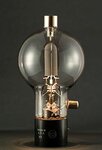dineshdeshmuk
Full Member level 5
Difference between semiconductors Vs. Solid State Vs. electronics Vs. Vacuum tubes ?
thanks
thanks
Follow along with the video below to see how to install our site as a web app on your home screen.
Note: This feature may not be available in some browsers.
Difference between semiconductors Vs. Solid State Vs. electronics Vs. Vacuum tubes ?
thanks
Can be little more precise ? In what situation ?
Tubes have not entirely been left behind.
Many music enthusiasts claim tube amplification sounds better than solid state. It has to do with a tube generating even harmonics when it distorts whereas solid state equipment generates odd harmonics.
Tubes can carry more power than solid state. I heard radio & tv broadcasting stations often have a very large tube in the final transmitting stage.
Tubes are not ruined by EMP (unlike solid state). I heard the Russian military still uses tube equipment for this reason. Even in their fighter jets. (My information may be outdated.)
How about that? I see you replied right away while I was going back to edit.

Yes the Vacuum Tube audio amplifier has the Best Quality in reproducing Audio. No solid state device can give that quality as even in MOSFETS there is a resistance offered to current but not in vacuum tubes.
And the Tube amps do not have any. If the design is proper. I have came across many Solid State amps which have the worst teasing voice to ears.Solid state amplifiers can have a much lower level of distortion
And the Tube amps do not have any. If the design is proper.
This clarifies what I mean. You quote it yourself. No amplification in the World without distortion BUT YES FOR THE SAKE OF discussion ONLY.So maybe extremely low distortion perhaps below any measurable value but not distortion less.